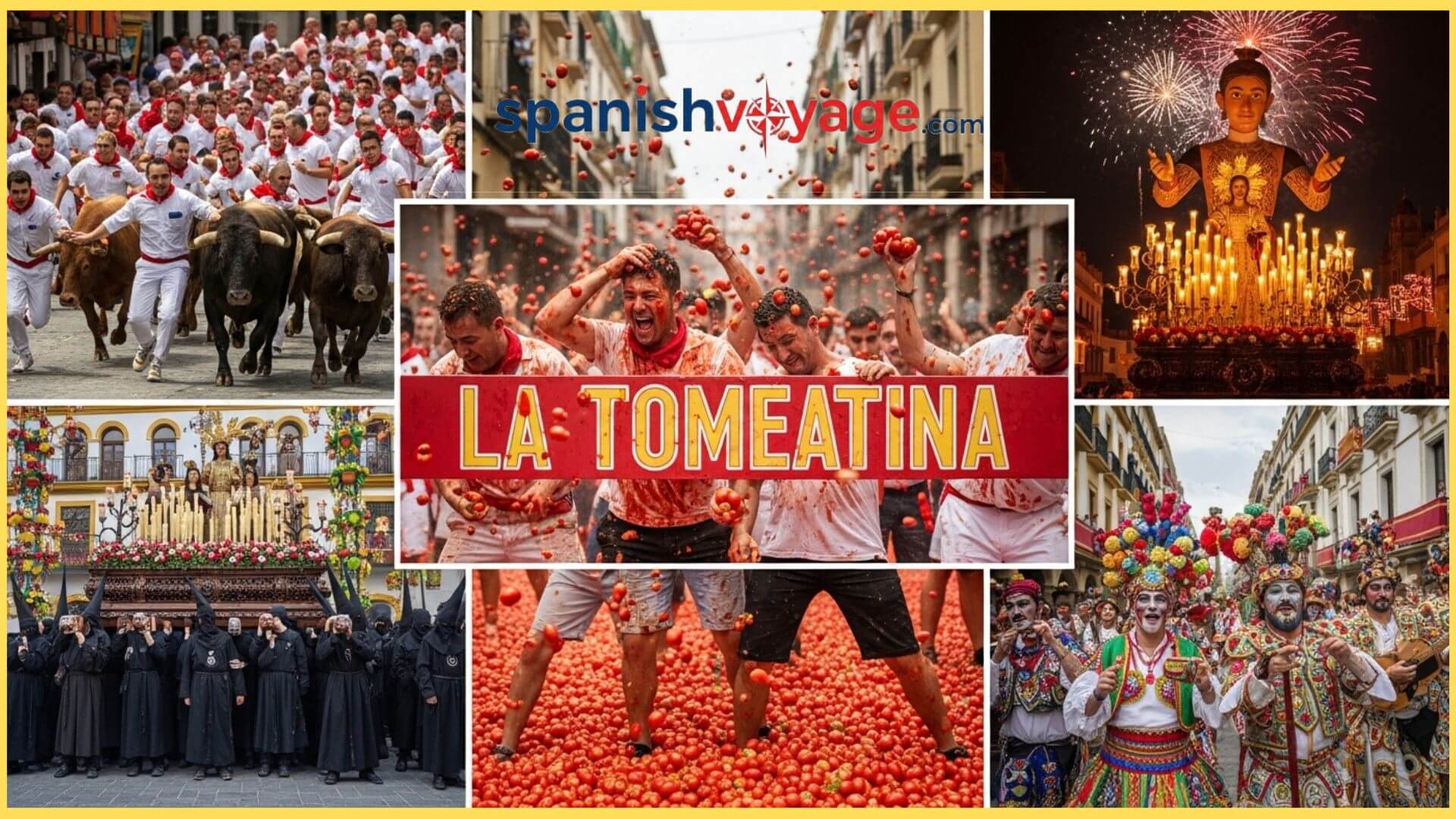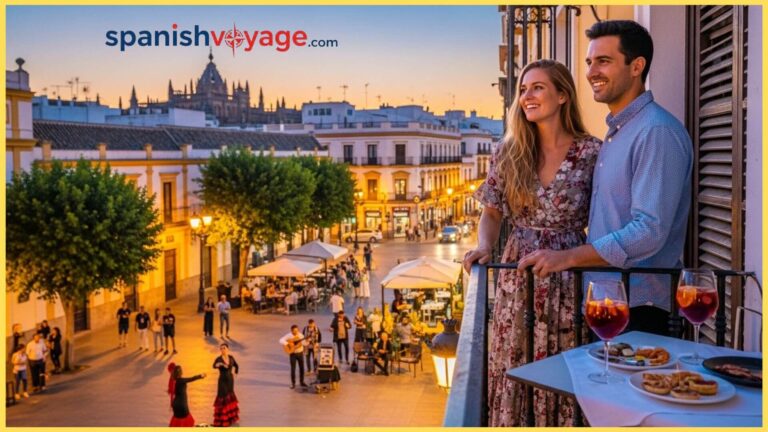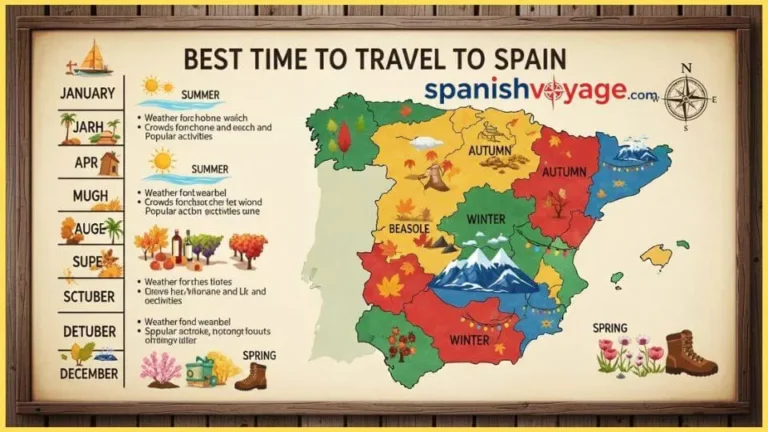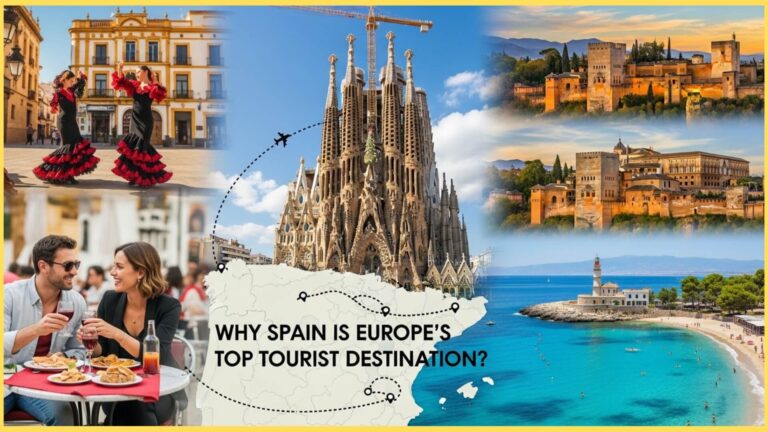Incredible Festivals in Spain You Can’t Miss
Let’s talk about Spain and festivals – because honestly, this country doesn’t just throw parties, it creates legendary experiences that’ll spoil you for celebrations everywhere else. I’m talking about events where entire cities transform overnight, strangers become instant friends, and you’ll find yourself doing things you never imagined (like throwing tomatoes at people or running from bulls – more on that later).
Spain’s festival game is absolutely unmatched. We’re dealing with a country that’s mastered the art of celebration over centuries, where each region brings its own wild traditions, incredible food, and infectious energy. Whether you’re into massive street parties, ancient religious processions, or just want to see how locals really let loose, Spain’s got something that’ll blow your mind.
Why Visit Spain for Festivals
Here’s the thing about Spanish festivals – they’re not tourist attractions pretending to be authentic. These are real celebrations with deep roots, where locals genuinely want you to join in the chaos. Spain’s regional diversity means every area has its own unique spin on partying, from the fiery passion of Andalusia to the quirky traditions of the Basque Country.
The combination is incredible: world-class music, food that’ll ruin you for eating anywhere else, art installations that belong in museums, and traditions so old they predate most countries. Plus, Spaniards have this amazing ability to make everyone feel welcome – you’ll go from tourist to honorary local faster than you can say “¡Olé!”
Planning tip: Book everything early. I mean it – accommodation during major festivals can cost 3-4 times the normal price, and availability disappears fast. Spring and summer are festival season, but honestly, something amazing is happening year-round.
Top Festivals You Can’t Miss
La Tomatina – Buñol, Valencia
This is probably the most famous “wait, people do what?” festival in the world. Every last Wednesday in August, the tiny town of Buñol becomes a massive tomato fight involving around 20,000 people and about 150,000 tomatoes. It’s exactly as messy and ridiculous as it sounds, and absolutely incredible.
The whole thing lasts about an hour, but the energy is insane. Picture being in the middle of the world’s biggest food fight while Spanish music blares and everyone’s laughing and covered head-to-toe in tomato pulp. It’s pure, joyful chaos.
Essential tips: Wear clothes you can throw away, bring goggles, and waterproof your phone. The town provides some cleanup facilities, but you’ll be finding tomato seeds in weird places for days. Tickets sell out months ahead, so plan early.
Running of the Bulls – San Fermín, Pamplona
Look, I’m not gonna sugarcoat this – running with bulls is dangerous. But San Fermín is about way more than just the morning bull runs. This week-long party in July transforms Pamplona into one giant celebration with incredible food, traditional music, and a festive atmosphere that’s impossible to resist.
If you’re not brave (or crazy) enough to run, watching from the balconies is still thrilling. The whole city wears white with red scarves, and the energy builds from about 6 AM when the rockets signal the start. But honestly, the evening parties, street food, and cultural events are just as memorable as the famous run.
Safety first: If you’re thinking about running, do your research. Seriously. There are specific rules, routes to learn, and safety considerations that could save your life.
Las Fallas – Valencia
March in Valencia is absolutely magical thanks to Las Fallas. The entire city fills with massive, incredibly detailed sculptures called “fallas” – we’re talking 30-foot tall satirical masterpieces that take months to create. Then, on the final night, they burn almost all of them in spectacular fashion.
The artistry is mind-blowing. These aren’t just big puppets – they’re complex works of art with incredible detail and often hilarious social commentary. The final night’s burning (La Cremà) is intense and emotional, with fireworks, crowds, and this bittersweet feeling of watching months of work go up in flames.
Don’t miss: The daily 2 PM mascletà (firecracker displays) in the main plaza. The noise and energy will give you chills. Also, try the traditional buñuelos – these sweet fritters are everywhere during the festival.
Feria de Abril – Seville
If you want to see Andalusian culture in all its flamenco-dancing, horse-riding, sherry-sipping glory, Seville’s April Fair is where it’s at. The fairground fills with hundreds of casetas (decorated tents) where families, businesses, and clubs host private parties that often welcome friendly visitors.
The traditional dress is stunning – women in colorful flamenco dresses, men in short jackets and tight trousers, and horses decked out in beautiful gear. The dancing is incredible, the food is phenomenal, and the atmosphere is pure Andalusian magic.
Getting in: Many casetas are private, but public ones welcome everyone. Ask locals for recommendations, and don’t be shy about striking up conversations – Sevillanos are incredibly welcoming during the fair.
Carnival of Santa Cruz de Tenerife
The Canary Islands’ answer to Rio Carnival is absolutely spectacular. February brings elaborate costumes, incredible parades, and a party atmosphere that lasts for weeks. The creativity in the costumes is off the charts – people spend months creating these masterpieces.
The drag queen competitions are legendary (seriously, the costumes cost more than cars), the street parties go all night, and the whole island basically stops functioning for carnival week. It’s Spain’s biggest carnival, and the energy is infectious.
Pro tip: The gala elections are ticketed events worth attending, but the street carnival is free and just as amazing. Pack comfortable shoes – you’ll be dancing in the streets.
Semana Santa – Holy Week
Holy Week processions happen across Spain, but experiencing them in Seville, Málaga, or Valladolid is unforgettable. These aren’t just religious ceremonies – they’re deeply emotional cultural events with incredible artistry and centuries of tradition.
The processions feature elaborate floats carrying religious sculptures, accompanied by hooded penitents and haunting music. In Seville, some processions take 12+ hours to complete their route through the narrow streets. The atmosphere is intense, respectful, and absolutely moving.
Best experience: Find a local bar along the procession route. You’ll get incredible food, wine, and commentary from locals who’ve been watching these processions their entire lives.
Other Notable Festivals
Festa Major de Gràcia (Barcelona) – Entire neighborhoods transform with incredible decorations in August.
Wine Battle of Haro (La Rioja) – June brings the world’s messiest wine fight. Bring white clothes.
Sónar Festival (Barcelona) – Electronic music and digital arts festival that’s pushing boundaries every year.
Travel Tips for Festival-Goers
Accommodation strategy: Book the second you know you’re going. Seriously. I’ve seen hotel prices triple during major festivals. Consider staying in nearby towns and taking trains in – sometimes it’s your only option.
Transport survival: Public transport gets completely overwhelmed during festivals. Download offline maps, learn the metro/bus systems, and always have backup plans. Walking often becomes your best option.
Cultural respect: Join in, but follow local leads. Don’t be the tourist who ignores safety guidelines or disrespects traditions. Spaniards love sharing their culture, but respect goes a long way.
Sustainability matters: Bring reusable water bottles, don’t litter, and support local businesses. These festivals rely on tourism, but they also need to preserve their communities.
Best Time to Plan Your Spanish Festival Trip
Spring (March-May): Las Fallas, Semana Santa, Feria de Abril
Summer (June-August): San Fermín, La Tomatina, neighborhood festivals
Fall (September-November): Harvest festivals, La Mercè in Barcelona
Winter (December-February): Carnival season, Christmas markets
Weather varies dramatically by region – the north can be rainy while the south is sunny, so check local forecasts and pack accordingly.
Your Spanish Festival Adventure Awaits
Spain’s festivals aren’t just events you attend – they’re experiences that change how you think about celebration, community, and pure joy. Whether you want to throw tomatoes, watch incredible art burn, dance flamenco until dawn, or witness centuries-old traditions, Spain delivers experiences you literally can’t get anywhere else.
The key is picking your festival based on what genuinely excites you, planning ahead (seriously, can’t stress this enough), and being ready to embrace whatever craziness comes your way. Trust me, you’ll come home with stories that sound too wild to be true, new friends from around the world, and probably plans to come back next year.
FAQ
Do I need to speak Spanish to enjoy the festivals?
Nope! The energy and visual spectacle speak for themselves. Plus, festival crowds are incredibly welcoming to tourists, and you’ll pick up key phrases quickly.
Are Spanish festivals safe?
Generally very safe, though crowds can be intense. Follow basic safety guidelines, stay aware of your surroundings, and respect any festival-specific safety rules (especially for events like San Fermín).
How much should I budget for a festival trip?
Accommodation during major festivals can cost €100-300+ per night. Budget extra for food, drinks, and any ticketed events. Many street festivals are free to join.
Can I participate even if I’m not Spanish?
Absolutely! Most festivals welcome international visitors. Just be respectful, follow local customs, and don’t be afraid to ask locals for advice.
So, which festival’s calling your name? Whatever you choose, you’re in for experiences that’ll spoil you for boring celebrations forever. Spain doesn’t do anything halfway, especially when it comes to partying – and trust me, you wouldn’t want it any other way.







